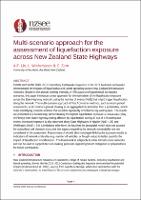| dc.contributor.author | Lin, Amelia | |
| dc.contributor.author | Wotherspoon, Liam | |
| dc.contributor.author | Zorn, Conrad | |
| dc.date.accessioned | 2024-07-01T02:01:15Z | |
| dc.date.available | 2024-07-01T02:01:15Z | |
| dc.date.issued | 2024-04-09 | |
| dc.identifier.uri | https://repo.nzsee.org.nz/xmlui/handle/nzsee/2720 | |
| dc.description.abstract | Events such as the 2010-2011 Canterbury Earthquake Sequence or the 2016 Kaikōura earthquake demonstrated the impacts of liquefaction and lateral spreading across New Zealand infrastructure networks. Statistical liquefaction models based on geospatial data can be used to rapidly calculate the probability of liquefaction (manifestation) for large-scale networks. Using the simulated ground shaking intensity of approximately 500 historic and hypothetical earthquake scenarios, the liquefaction probability is estimated across the New Zealand State Highway network. The overall exposure is measured by the number of events that are expected to cause liquefaction manifestation along a road section, which could help identifying State Highways that might be affected by liquefaction manifestation during a range of different earthquakes, hence, might lead to a recurrent disruption of transport services. The results are linked to network criticality (One Network Road Classification) to estimate the impact of potential network damage due to liquefaction. The impact map indicates that high liquefaction impact can be expected in Whakatāne and Napier due to an increased number of earthquakes affecting the area in combination with higher network criticality. Limitations arise from the fact that the geospatial model does not account for subsurface soil characteristics and that vulnerability aspects of the State Highways are not considered in the assessment. Future research could investigate alternative criticality factors that better align with the interests of the stakeholders. The framework is adaptable to other infrastructure networks and can be used to support decision making processes regarding hazard mitigation or preparedness for future earthquakes. | |
| dc.language.iso | en | |
| dc.publisher | New Zealand Society for Earthquake Engineering | |
| dc.relation.ispartofseries | 2024;24 | |
| dc.subject | Design and performance of lifelines and infrastructure | |
| dc.title | Multi-scenario approach for the assessment of liquefaction exposure and impact across New Zealand State Highways | |
| dc.type | Article | |

